Construction workers face a higher risk of workplace injuries than those in many other industries. According to recent statistics, over 65,000 construction workers suffer non-fatal injuries every year in the UK, with the most common accidents involving falls from height, slips and trips, and being struck by moving objects.
On-site first aid is therefore crucial for addressing these injuries and mitigating their impact. First aid kits tailored to the unique risks and hazards of the construction industry are essential for prompt and effective treatment of injuries.
Construction companies must prioritize workplace safety to protect their employees and minimize the risk of accidents and injuries. In this article, we will discuss the importance of first aid kits, safety equipment, and training for construction workers.
Key Takeaways
- Construction workers face a higher risk of workplace injuries than many other industries.
- First aid kits tailored to the unique risks and hazards of the construction industry are essential for prompt and effective treatment of injuries.
- Construction companies must prioritize workplace safety to protect their employees and minimize the risk of accidents and injuries.
The Importance of Construction Safety Equipment
Construction safety equipment is essential for preventing on-site injuries and promoting workplace safety. The construction industry can be hazardous, with workers at risk of injuries caused by falling objects, sharp tools, and heavy machinery. Therefore, it’s essential to take proactive measures to mitigate these risks by using appropriate safety equipment.
There are various types of construction safety equipment that workers can use to prevent injuries, including hard hats, safety goggles, and high-visibility vests. These pieces of equipment can protect workers from falling objects, flying debris, and other hazards present on construction sites. Wearing protective gear is especially important for workers operating machinery or working at heights.
In addition to using the appropriate safety equipment, workers must also use it correctly. Wearing a hard hat won’t protect a worker if it’s not fitted correctly. Similarly, safety goggles won’t provide adequate protection if they’re not worn over the eyes. Employers must ensure workers receive proper training on how to use safety equipment to prevent accidents and injuries.
Using the appropriate safety equipment can significantly reduce the risk of accidents and injuries in the construction industry. However, safety equipment is only one aspect of promoting workplace safety. Employers must also implement safety protocols, provide adequate training, and promote a culture of safety in the workplace.
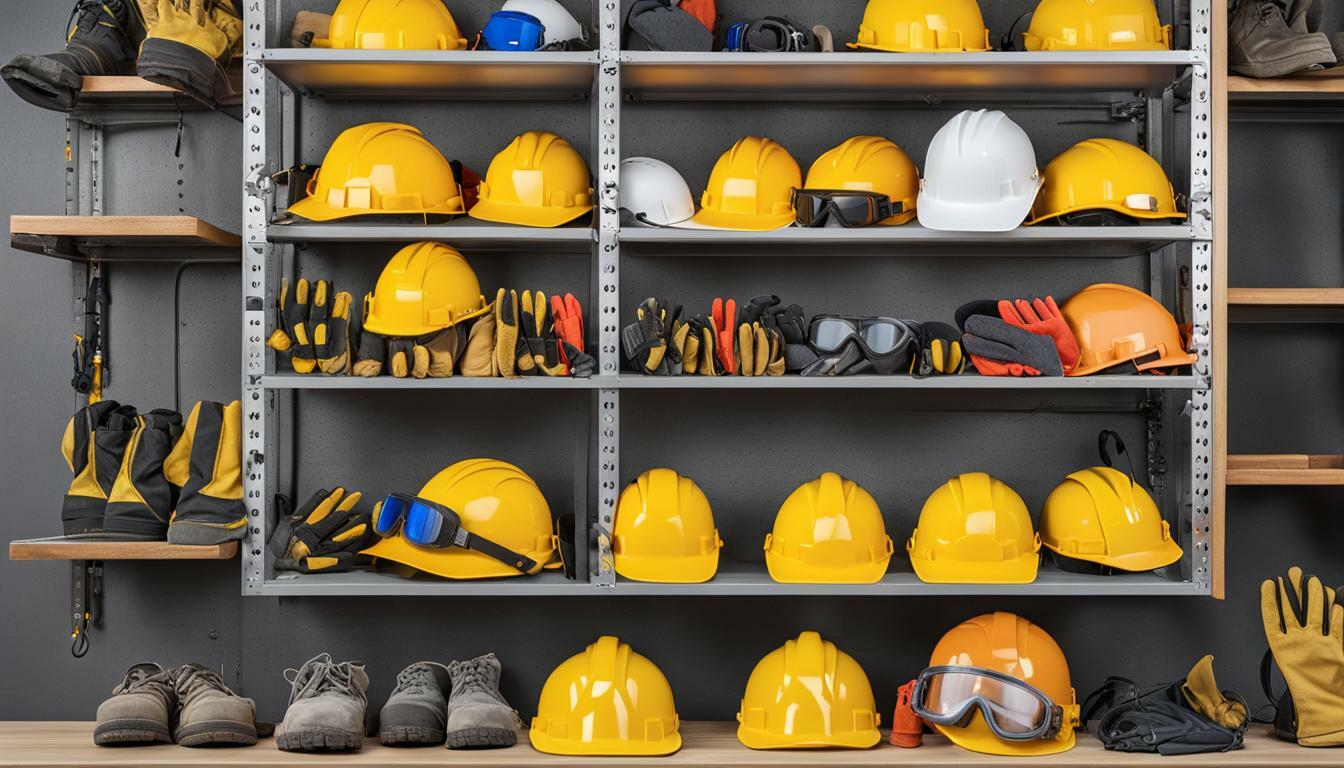
By prioritizing workplace safety, employers can create a safer working environment for construction workers. Workers must also be aware of the risks they face on-site and comply with safety protocols to prevent accidents and injuries. Together, employers and workers can create a culture of safety that prioritizes the well-being of everyone on the construction site.
Essential Components of First Aid Kits for Construction Workers
When it comes to on-site first aid, having the right supplies available can make all the difference. Therefore, it is crucial for construction workers to have access to first aid kits that are specifically tailored to their needs. Here are some essential components that should be included in First Aid Kits for Construction Workers:
- Bandages: A variety of bandages, including adhesive, triangular, and elastic bandages, should be included to address cuts, scrapes, and other minor injuries that are common on construction sites.
- Dressings: Different types of dressings such as sterile gauze, non-adherent dressings, and transparent dressings should be included to provide coverage for wounds and minimize the risk of infection.
- Antiseptics: Solutions such as antiseptic wipes, hydrogen peroxide, and alcohol should be included to clean wounds and prevent infection.
- Splints: Injuries such as fractures and sprains are common on construction sites, so including splints in first aid kits can provide support and alleviate pain until medical help arrives.
Regularly restocking first aid kits is also essential to ensure they are always well-equipped. This should be done at least once every six months, or more frequently if necessary. First aid kits should also be stored in a location that is easily accessible and known to all workers.
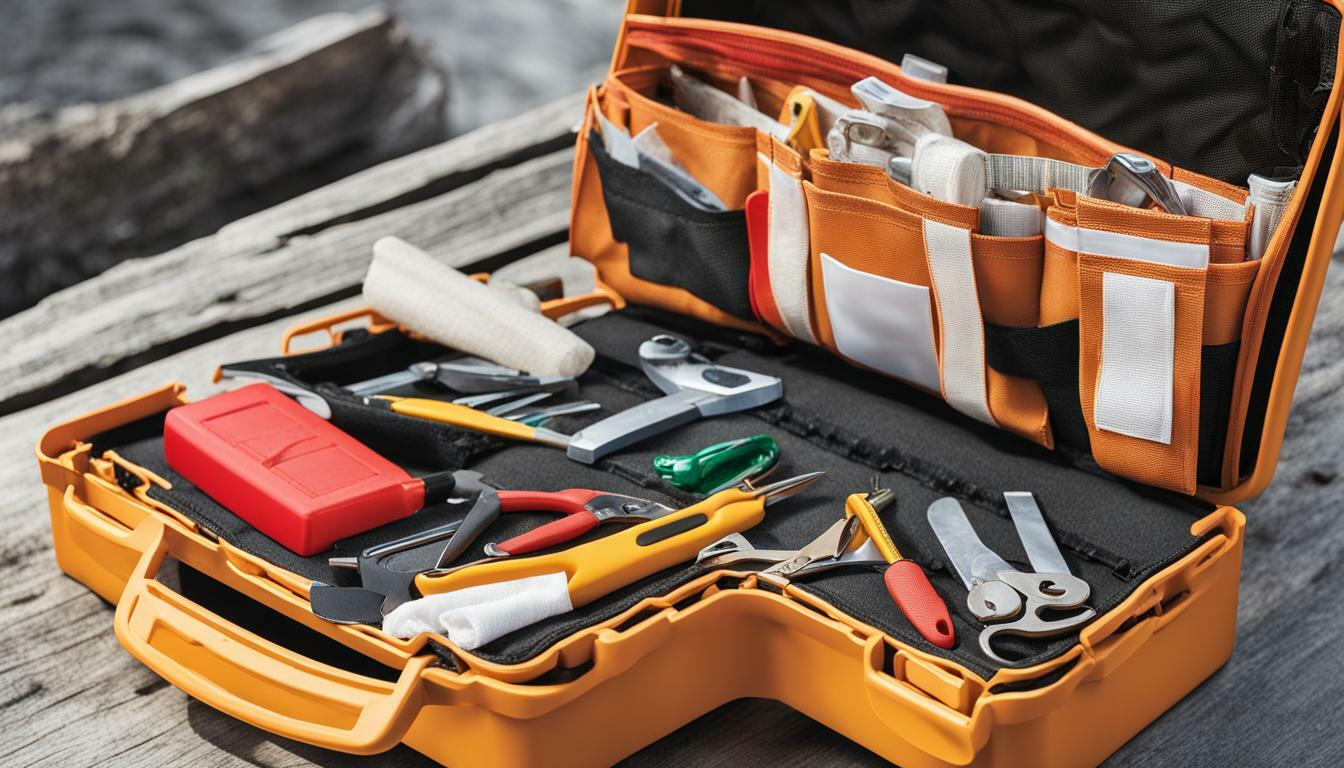
Choosing First Aid Supplies
It’s important to choose first aid supplies that are safe, effective, and comply with regulatory standards. When selecting first aid kits, consider factors such as size, portability, and ease of use. While it’s important to have comprehensive first aid kits, they should also be easy to carry around and store. On-site first aid supplies can save lives, and it’s worth taking the time to ensure that yours are right for your workplace and workers.
Providing Construction First Aid Training
Construction sites are inherently hazardous, and workers are prone to injuries. Providing construction-first-aid-training is essential to ensure that workers are equipped with the knowledge and skills to handle on-site injuries promptly and effectively.
Effective training on first aid in construction involves equipping workers with the necessary skills to deal with on-site injuries, adequately assessing risks, and taking proactive measures to mitigate risks in the workplace. Employers have a duty to ensure that workers have competent training to perform their work safely.
Training courses available vary in duration and content. Some basic programs can be completed online, while others take place over several days. On-site first-aid training can be tailored to fit specific needs and provide hands-on experience in first-aid emergencies. Workers can also undertake certification programs to obtain recognized qualifications.
Training should not be a one-time event; regular refresher courses are essential to keep skills up to date. This helps to ensure that workers can respond effectively to new challenges and technologies in the workplace. Refresher training can take place every three years or sooner if there are revisions to procedures, or if there is a change of equipment or workplace layout.
Training workers on first aid in construction can help employers to reduce the risk of workplace accidents and ensure compliance with health and safety regulations. It can also be an effective way to demonstrate an employer’s commitment to the health and safety of their workers.
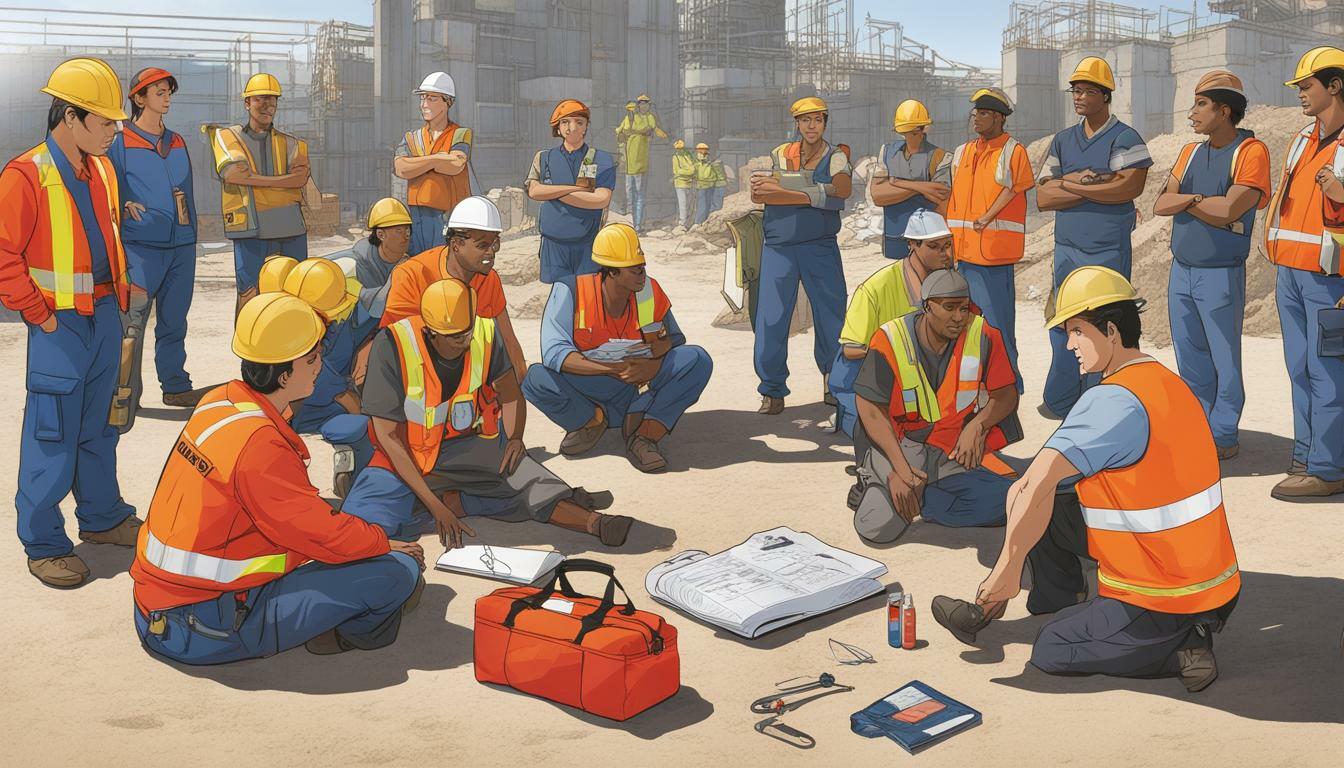
Implementing Construction Safety Measures
The importance of workplace safety cannot be overstated in the construction industry. It is crucial to implement effective construction safety measures to prevent on-site injuries and promote a safer working environment for construction workers.
Regular safety inspections are vital to identify potential hazards and mitigate the risk of accidents. Hazard assessments should also be conducted regularly to ensure all necessary precautions are taken to prevent accidents from occurring.
Providing safety signage in areas where hazards have been identified can also help prevent accidents. High-visibility clothing should be worn by workers in areas where there is a risk of not being seen by others.
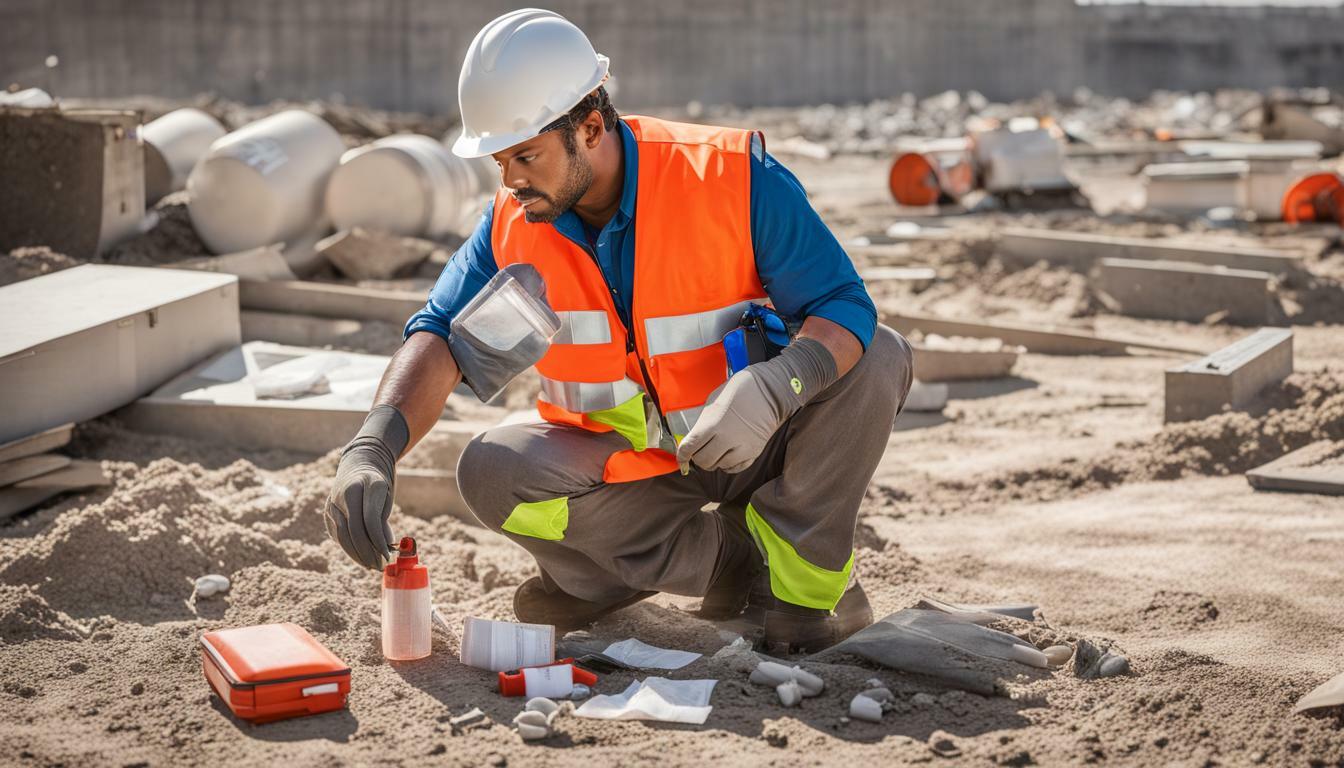
Other essential construction safety measures include the use of personal protective equipment, such as hard hats, safety goggles, and gloves. These items can help workers avoid injury in case of accidents.
It is vital to ensure that all construction equipment is maintained and serviced to prevent malfunction and reduce the risk of accidents. Adequate training must be provided to workers who operate specialized machinery or equipment.
By implementing effective construction safety measures, employers can help protect the health and safety of their workers while also ensuring compliance with health and safety regulations.
Common Construction Site Injuries
Construction sites are known to be hazardous places, where an accident can happen at any time. Workers are exposed to a variety of dangers, and despite the implementation of safety measures, accidents can and do occur. Being prepared for on-site injuries is crucial for the safety and well-being of construction workers.
One of the most common types of construction site injury is a fall from a height. Whether it’s from scaffolding, roofs or ladders, falls are a significant risk for workers. Another prevalent injury is cuts and lacerations, resulting from the use of sharp tools and equipment. Burns, from chemicals, fire or hot surfaces, are also common in the construction industry. Lastly, sprains and strains are another frequent injury, usually caused by overexertion or incorrect lifting techniques.
It’s essential for construction workers to be aware of the potential dangers and take necessary precautions to prevent injuries from occurring. This includes the use of appropriate personal protective equipment, such as hard hats and safety goggles, and following established safety procedures.
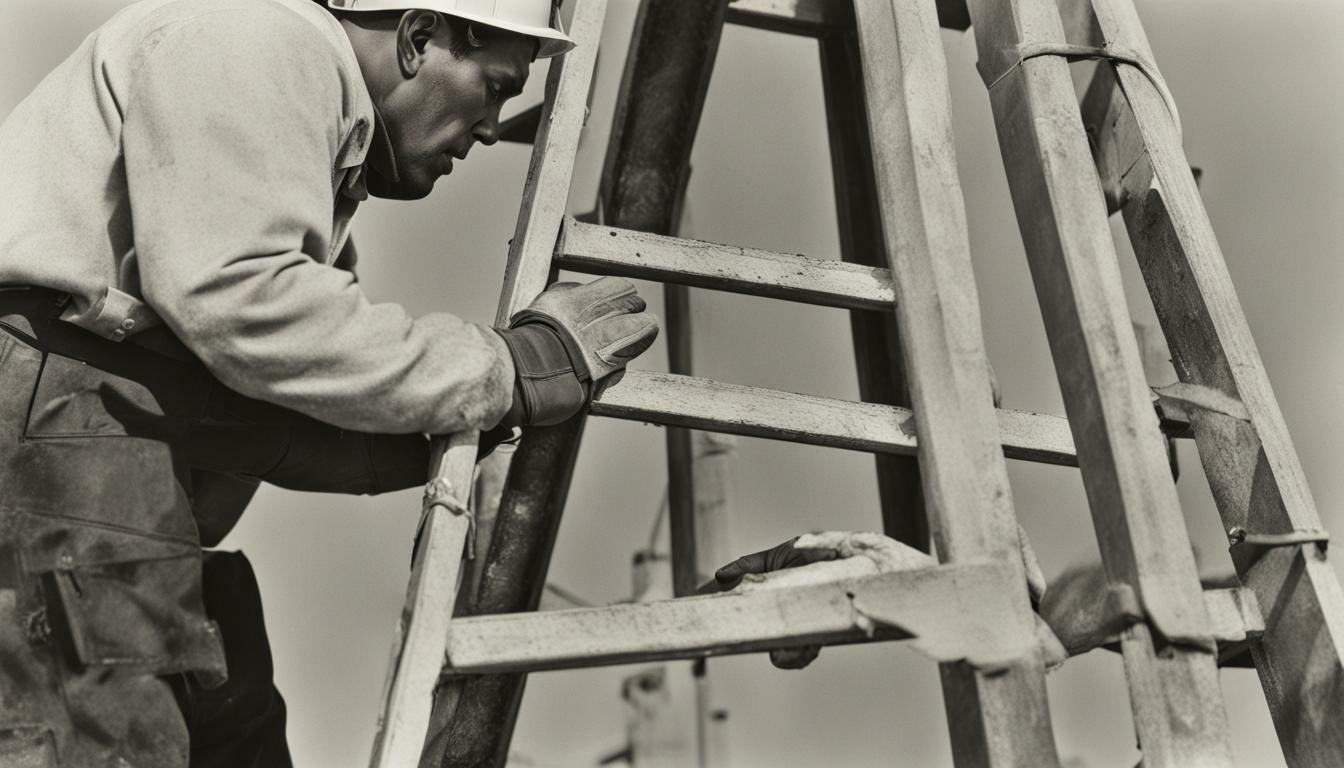
Addressing injuries immediately is also paramount. Having a well-stocked first aid kit with necessary supplies, such as bandages and antiseptics, is essential for prompt injury management. Proper training in first aid and injury prevention can also help workers to act swiftly and with confidence in an emergency.
By being prepared for on-site injuries and taking necessary precautions, construction workers can reduce the risk of accidents and ensure workplace safety on construction sites.
On-Site Injury Management for Construction Workers
Construction sites can be hazardous, with accidents and injuries occurring frequently. In the event of an injury, it is important to respond promptly and effectively to minimize the extent of the damage. On-site injury management is a crucial component of workplace safety, and all construction workers should receive training on how to manage an injury if it occurs.
If an injury occurs, the first step is to assess its severity. Minor injuries, such as cuts or bruises, can typically be treated on-site with basic first aid supplies. However, more severe injuries, such as broken bones or head injuries, require immediate medical attention. It is important to contact emergency services as soon as possible if the situation warrants it, and to follow any relevant protocols or guidelines provided by the employer or site manager.
A well-stocked first aid kit is essential for addressing on-site injuries quickly and efficiently. Ensure that the kit contains the necessary supplies, such as bandages, dressing, antiseptics, and splints. It is important to regularly restock and update the kit to ensure that the supplies are up to date and in good condition.
In addition to providing first aid supplies, employers should also ensure that workers receive proper training on how to manage on-site injuries. This training should cover basic first aid techniques, such as how to stop bleeding and how to stabilize injured limbs. Workers should also be trained on how to properly assess the extent of an injury and when to seek additional medical attention.
Documentation is an essential component of on-site injury management. All injuries should be properly documented to ensure that appropriate follow-up measures can be taken. Documentation can include incident reports, witness statements, and photographs or video footage if available.
Implementing effective on-site injury management protocols is crucial for promoting workplace safety in the construction industry. By taking a proactive approach to injury prevention and management, employers and workers can work together to create a safer and healthier working environment.

Ensuring workplace safety is the responsibility of every member of the construction industry. By prioritizing injury prevention and effective injury management, we can create safer and healthier workplaces for all construction workers.
Ensuring Compliance with Health and Safety Regulations
Compliance with health and safety regulations is crucial to ensuring workplace safety on construction sites in the UK. Employers and workers have legal obligations to provide safe working environments and prevent accidents and injuries. Failure to comply with regulations can result in serious consequences, including fines and legal action.
Construction safety measures must meet the requirements set out in various regulations and standards, including the Health and Safety at Work Act, the Construction (Design and Management) Regulations, and the Personal Protective Equipment at Work Regulations. It is essential to stay up to date with the latest regulations and ensure that all safety measures are in compliance.
Implementing and maintaining effective safety measures requires a collaborative effort between employers, workers, and regulatory authorities. Regular safety inspections and hazard assessments can identify potential risks and allow for preventive measures to be taken. Employers should also provide safety training and clearly communicate safety policies and procedures to workers.
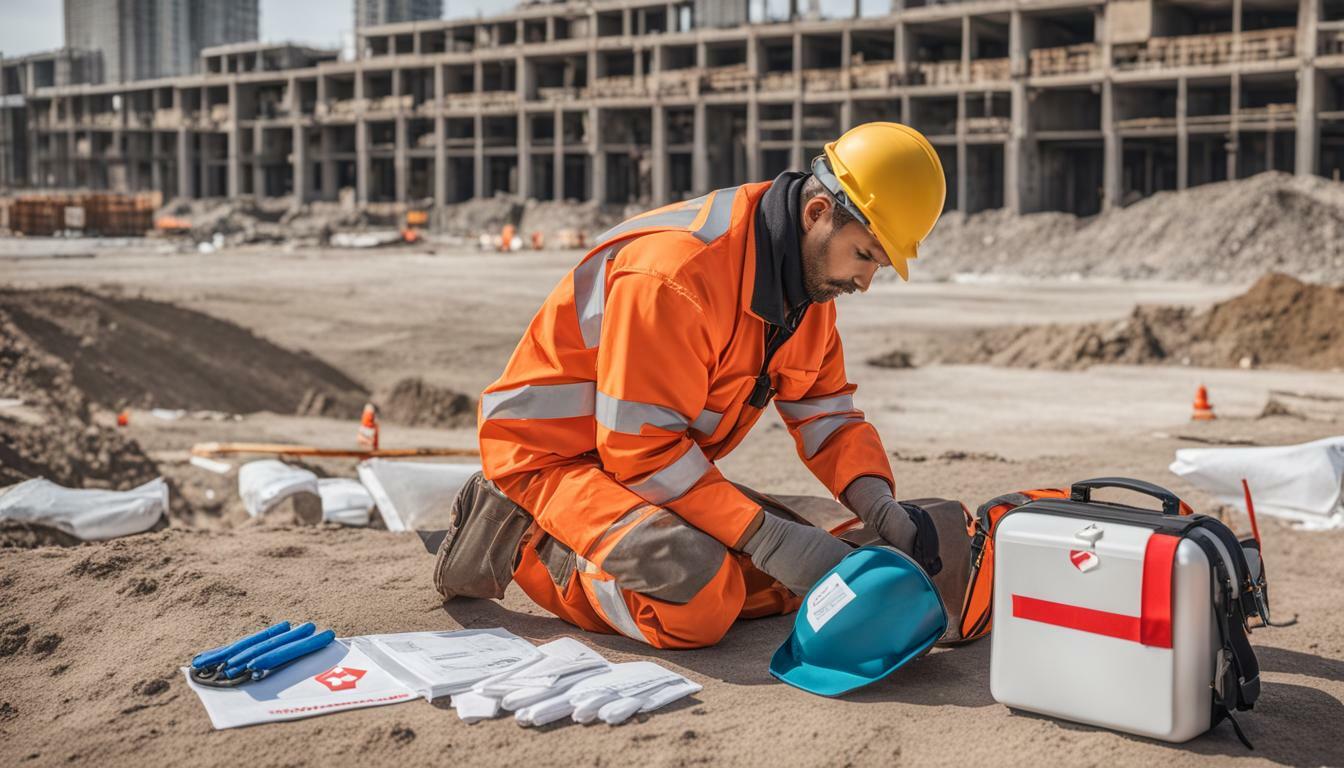
Ensuring compliance with health and safety regulations is essential to protecting construction worker health and safety. It can also provide numerous benefits, such as reduced accidents and injuries, improved worker morale and productivity, and increased public confidence in the construction industry. Prioritizing workplace safety should be a top priority for all employers and workers in the construction industry.
Evaluating First Aid Kits for Construction Workers
Providing first aid kits for construction workers is essential for addressing on-site injuries and promoting workplace safety. However, not all first aid kits are created equal, and it is crucial to evaluate their effectiveness and suitability for the job.
When evaluating first aid kits for construction workers, it is important to consider factors such as size, portability, and compliance with regulatory standards. The kit should be easily accessible and transportable, considering the often-changing work environments in the construction industry. The contents should be adequate to address common construction-related injuries, such as cuts, burns, and sprains.
Some essential components that should be included in the first aid kit are:
| Item | Purpose |
|---|---|
| Bandages and Dressings | For covering wounds and stopping bleeding |
| Antiseptics | To disinfect and clean wounds |
| Splints | To immobilize injured limbs |
Regularly restocking the first aid kit is also crucial to ensure that it is always well-equipped at all times.
When sourcing for reliable suppliers of first aid kits, look for those that specialize in providing first aid supplies for the construction industry. It is also recommended to compare multiple suppliers and their products to ensure that you get the best quality at a reasonable price.
Having an effective first aid kit in place for construction workers is an important part of maintaining workplace safety and preventing on-site injuries. By evaluating and selecting the most suitable first aid kits for construction workers, employers can ensure that their workers are prepared to handle any emergencies that may arise.

Training Resources and Courses for Construction First Aid
Proper first aid training is vital for the safety and well-being of construction workers. There are many training resources and courses available to help construction workers acquire the knowledge and skills they need to handle on-site injuries. These resources can be accessed online or through in-person courses.
Online Training Resources
Online training resources can be accessed at any time and from anywhere, making them a flexible option for construction workers with busy schedules. These resources offer a range of courses and modules on first aid, workplace safety, and construction site health and safety.
Some reputable online training resources for construction first aid include:
- The Institution of Occupational Safety and Health (IOSH): Offers online courses on construction safety and first aid.
- Construction Helpline: Provides online courses and resources on construction site health and safety.
- The Health and Safety Executive (HSE): Offers a range of online courses on first aid, workplace safety, and other related topics.
In-Person Courses and Certification Programs
In-person courses and certification programs offer construction workers hands-on training and practical experience in handling on-site injuries. These programs typically involve classroom instruction, simulations, and group exercises.
Some reputable in-person courses and certification programs for construction first aid include:
- St John Ambulance: Offers a range of first aid courses tailored for construction workers.
- The British Red Cross: Provides first aid training courses for construction workers and other related industries.
- The Royal Society for the Prevention of Accidents (RoSPA): Provides health and safety training and certification programs for construction workers.

Investing in first aid training for construction workers is an essential component of ensuring workplace safety and preventing on-site injuries. By equipping workers with the knowledge and skills to handle emergencies, construction sites can be made safer for workers and the public.
Conclusion
In conclusion, prioritizing workplace safety and implementing construction safety measures is crucial to ensuring the health and safety of construction workers on-site. First aid kits for construction workers that contain essential components tailored to specific risks can make a significant difference in addressing on-site injuries.
Providing workers with the proper training in first aid and injury management empowers them to handle emergencies efficiently and effectively. Additionally, regularly evaluating and restocking first aid kits and sourcing reliable suppliers are essential steps to maintain the effectiveness of the kits.
Adhering to health and safety regulations is not only a legal and ethical obligation but also beneficial in preventing accidents and injuries. Available training resources and courses for construction first aid offer workers and employers a way to stay up-to-date and ensure they are adequately prepared to handle on-site emergencies.
Therefore, let us take measures to ensure the safety and well-being of construction workers and prioritize workplace safety in the UK.
